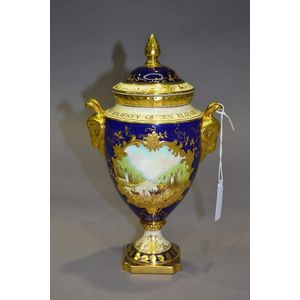Autumnal Fruit Coalport Urn
You must be a subscriber, and be logged in to view price and dealer details.
Subscribe Now to view actual auction price for this item
When you subscribe, you have the option of setting the currency in which to display prices to $Au, $US, $NZ or Stg.
- Knop (ceramics) - In ceramics, a knop is a protuberance on the top of an object, and can be either decorative, or used as a knob to lift the item.
- Gilding - Gilding is a method of ornamentation whereby a thin sheet of gold metal is applied to items made of wood, leather, ceramics, glass and silver for decorative purposes.
For furniture including mirrors, the sheet of gold is usually applied over a coating of gesso. Gesso is a mixture of plaster of Paris and gypsum mixed with water and then applied to the carved wooden frames of mirrors and picture frames as a base for applying the gold leaf. After numerous coats of gesso have been applied, allowed to dry and then sanded a coat of "bole", a usually red coloured mixture of clay and glue is brushed on and allowed to dry, after which the gold leaf is applied. Over time parts of the gilding will rub off so the base colour can be seen. In water gilding, this was generally a blue colour, while in oil gilding, the under layer was often yellow. In Victorian times, gilders frequently used red as a pigment beneath the gold leaf.
Metal was often gilded by a process known as fire gilding. Gold mixed with mercury was applied and heated, causing the mercury to evaporate, the long-term effect of which was to kill or disable the craftsman or woman from mercury poisoning. The pursuit of beauty has claimed many victims, not the least of which were the artists who made those pieces so highly sought after today. - Socle - The short plinth, usually cylindrical, that serves as a pedestal for a sculpture or vase
This item has been included into following indexes:
- Coalport and Coalbrookdale porcelain (England) - ceramics 526
-
Coalport porcelain (England), item type
- other items 155
- vases, ewers and urns 132
Visually similar items

A signed Coalport pedestal vase with cover. 1970s onwards, the urn form vase with ram's head gilded lug handles, a domed cover and pineapple finial, decorated throughout with naturalistic pears, apples and plums upon an autumnal ground, signed N. Lear; wit

Royal Worcester twin handled lidded vase C1918, with handpainted floral and gilt decoration, signed W Hart, height 32 cm approx

Coalport twin handled urn 'The Honour of her Majesty Queen Elizabeth II' (has firing cracks to handl. Coalport twin handled urn 'The Honour of her Majesty Queen Elizabeth II' (has firing cracks to handle area), approx 24 cm high

Large Fieldings England (Crown Devon) lidded twin, handle vase, handpainted with rose decoration, signed W.Lamonby, height 62 cm
